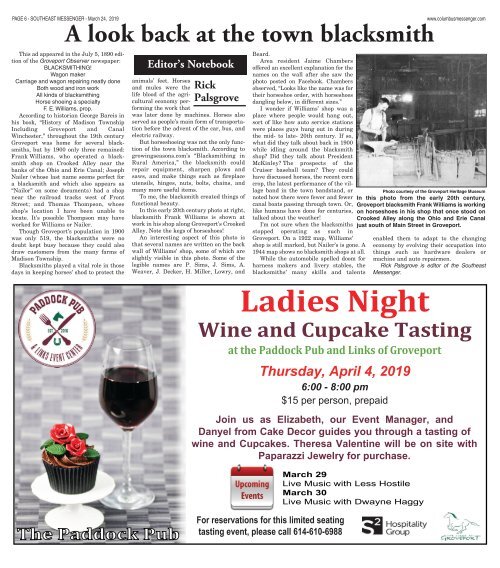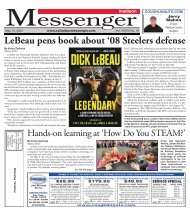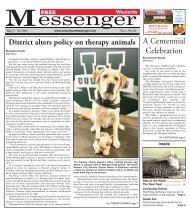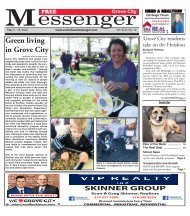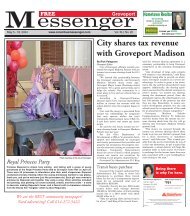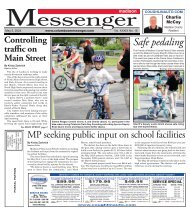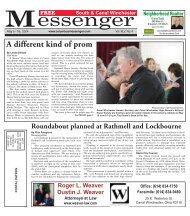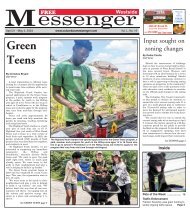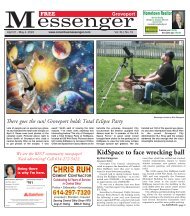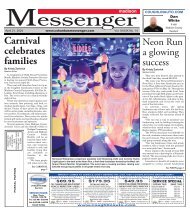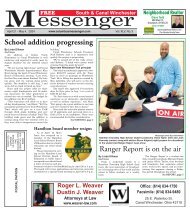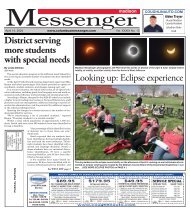You also want an ePaper? Increase the reach of your titles
YUMPU automatically turns print PDFs into web optimized ePapers that Google loves.
PAGE 6 - SOUTHEAST MESSENGER - <strong>March</strong> 24, <strong>2019</strong><br />
www.columbusmessenger.com<br />
A look back at the town blacksmith<br />
This ad appeared in the July 5, 1890 edition<br />
of the Groveport Observer newspaper:<br />
BLACKSMITHING!<br />
Wagon maker<br />
Carriage and wagon repairing neatly done<br />
Both wood and iron work<br />
All kinds of blacksmithing<br />
Horse shoeing a specialty<br />
F. E. Williams, prop.<br />
According to historian George Bareis in<br />
his book, “History of Madison Township<br />
Including Groveport and Canal<br />
Winchester,” throughout the 19th century<br />
Groveport was home for several blacksmiths,<br />
but by 1900 only three remained:<br />
Frank Williams, who operated a blacksmith<br />
shop on Crooked Alley near the<br />
banks of the Ohio and Erie Canal; Joseph<br />
Nailer (whose last name seems perfect for<br />
a blacksmith and which also appears as<br />
“Nailor” on some documents) had a shop<br />
near the railroad tracks west of Front<br />
Street; and Thomas Thompson, whose<br />
shop’s location I have been unable to<br />
locate. It’s possible Thompson may have<br />
worked for Williams or Nailer.<br />
Though Groveport’s population in 1900<br />
was only 519, the blacksmiths were no<br />
doubt kept busy because they could also<br />
draw customers from the many farms of<br />
Madison Township.<br />
Blacksmiths played a vital role in those<br />
days in keeping horses’ shod to protect the<br />
Editor’s Notebook<br />
animals’ feet. Horses<br />
and mules were the<br />
life blood of the agricultural<br />
economy performing<br />
the work that<br />
Rick<br />
Palsgrove<br />
was later done by machines. Horses also<br />
served as people’s main form of transportation<br />
before the advent of the car, bus, and<br />
electric railway.<br />
But horseshoeing was not the only function<br />
of the town blacksmith. According to<br />
growingseasons.com’s “Blacksmithing in<br />
Rural America,” the blacksmith could<br />
repair equipment, sharpen plows and<br />
saws, and make things such as fireplace<br />
utensils, hinges, nuts, bolts, chains, and<br />
many more useful items.<br />
To me, the blacksmith created things of<br />
functional beauty.<br />
In this early 20th century photo at right,<br />
blacksmith Frank Williams is shown at<br />
work in his shop along Groveport’s Crooked<br />
Alley. Note the kegs of horseshoes!<br />
An interesting aspect of this photo is<br />
that several names are written on the back<br />
wall of Williams’ shop, some of which are<br />
slightly visible in this photo. Some of the<br />
legible names are P. Sims, J. Sims, A.<br />
Weaver, J. Decker, H. Miller, Lowry, and<br />
Beard.<br />
Area resident Jaime Chambers<br />
offered an excellent explanation for the<br />
names on the wall after she saw the<br />
photo posted on Facebook. Chambers<br />
observed, “Looks like the name was for<br />
their horseshoe order, with horseshoes<br />
dangling below, in different sizes.”<br />
I wonder if Williams’ shop was a<br />
place where people would hang out,<br />
sort of like how auto service stations<br />
were places guys hung out in during<br />
the mid- to late- 20th century. If so,<br />
what did they talk about back in 1900<br />
while idling around the blacksmith<br />
shop? Did they talk about President<br />
McKinley? The prospects of the<br />
Cruiser baseball team? They could<br />
have discussed horses, the recent corn<br />
crop, the latest performance of the village<br />
band in the town bandstand, or<br />
noted how there were fewer and fewer<br />
canal boats passing through town. Or,<br />
like humans have done for centuries,<br />
talked about the weather!<br />
I’m not sure when the blacksmiths<br />
stopped operating as such in<br />
Groveport. On a 1922 map, Williams’<br />
shop is still marked, but Nailer’s is gone. A<br />
1944 map shows no blacksmith shops at all.<br />
While the automobile spelled doom for<br />
harness makers and livery stables, the<br />
blacksmiths’ many skills and talents<br />
Photo courtesy of the Groveport Heritage Museum<br />
In this photo from the early 20th century,<br />
Groveport blacksmith Frank Williams is working<br />
on horseshoes in his shop that once stood on<br />
Crooked Alley along the Ohio and Erie Canal<br />
just south of Main Street in Groveport.<br />
enabled them to adapt to the changing<br />
economy by evolving their occupation into<br />
things such as hardware dealers or<br />
machine and auto repairmen.<br />
Rick Palsgrove is editor of the <strong>Southeast</strong><br />
<strong>Messenger</strong>.<br />
Ladies Night<br />
Wine and Cupcake Tasting<br />
at the Paddock Pub and Links of Groveport<br />
Thursday, April 4, <strong>2019</strong><br />
6:00 - 8:00 pm<br />
$15 per person, prepaid<br />
Join us as Elizabeth, our Event Manager, and<br />
Danyel from Cake Decor guides you through a tasting of<br />
wine and Cupcakes. Theresa Valentine will be on site with<br />
Paparazzi Jewelry for purchase.<br />
<strong>March</strong> 29<br />
Live Music with Less Hostile<br />
<strong>March</strong> 30<br />
Live Music with Dwayne Haggy<br />
The Paddock Pub<br />
The Paddock Pub<br />
For reservations for this limited seating<br />
tasting event, please call 614-610-6988


